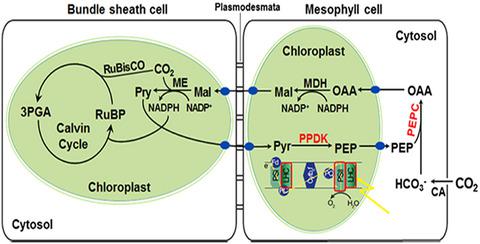当前位置:
X-MOL 学术
›
Plant Biol.
›
论文详情
Our official English website, www.x-mol.net, welcomes your
feedback! (Note: you will need to create a separate account there.)
Influence of salt stress on C4 photosynthesis in Miscanthus sinensis Anderss.
Plant Biology ( IF 4.2 ) Pub Date : 2020-10-08 , DOI: 10.1111/plb.13192 Qian Sun 1, 2 , Toshihiko Yamada 3 , Yulai Han 2 , Tetsuo Takano 1
更新日期:2020-10-08
Plant Biology ( IF 4.2 ) Pub Date : 2020-10-08 , DOI: 10.1111/plb.13192 Qian Sun 1, 2 , Toshihiko Yamada 3 , Yulai Han 2 , Tetsuo Takano 1
Affiliation

|
- Miscanthus sinensis Anderss. is a good candidate for C4 bioenergy crop development for marginal lands. As one of the characteristics of marginal lands, salinization is a major limitation to agricultural production. The present work aimed to investigate the possible factors involved in the tolerance of M. sinensis C4 photosynthesis to salinity stress.
- Seedlings of two accessions (salt‐tolerant ‘JM0119’ and salt‐sensitive ‘JM0099’) were subjected to 0 mm NaCl (control) or 250 mm NaCl (salt stress treatment) for 2 weeks. The chlorophyll content, parameters of photosynthesis and chlorophyll a fluorescence, activity of C4 enzymes and expression of C4 genes were measured.
- The results showed that photosynthesis rate, transpiration rate, chlorophyll content, PSII operating efficiency, coefficient of photochemical quenching, activity of phosphoenolpyruvate carboxylase (PEPC) and pyruvate, orthophosphate dikinase (PPDK) and gene expression of PEPC and PPDK under salinity were higher after long‐term salinity exposure in ‘JM0119’ than in ‘JM0099’, while activity of NADP‐malate dehydrogenase (NADP‐MDH) and NADP‐malic enzyme (NADP‐ME), together with expression of NADP‐MDH and NADP‐ME, were much higher in ‘JM0099’ than in ‘JM0119’.
- In conclusion, the increased photosynthetic capacity under long‐term salt stress in the salt‐tolerant relative to the salt‐sensitive M. sinensis accession was mainly associated with non‐stomatal factors, such as reduced chlorophyll loss, higher PSII operating efficiency, enhanced activity of PEPC and PPDK and relatively lower activity of NADP‐ME.











































 京公网安备 11010802027423号
京公网安备 11010802027423号